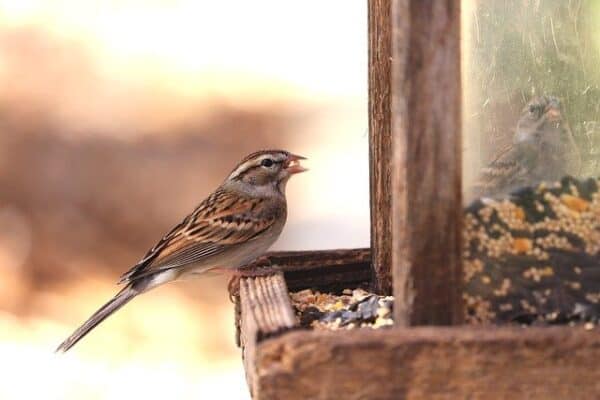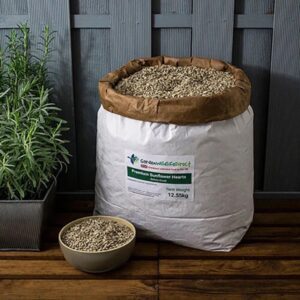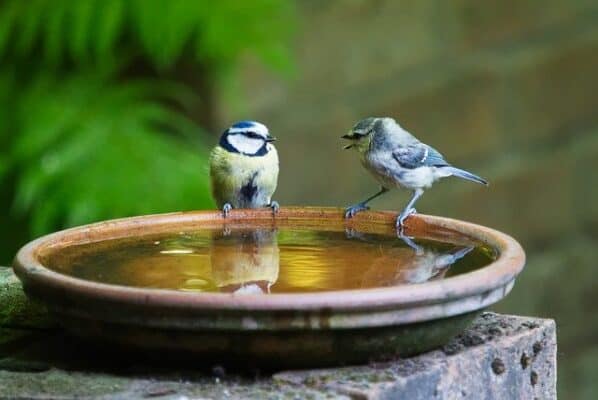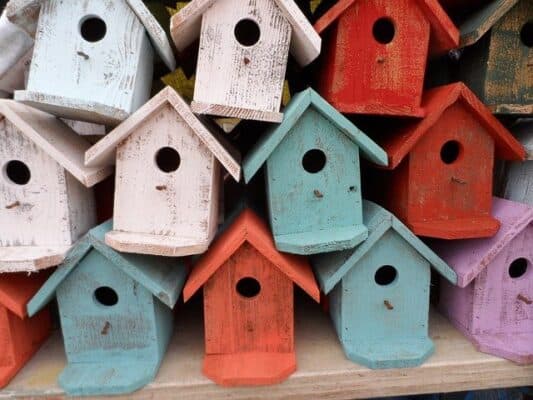My garden is full of wild birds morning and evening with the beauty of nature. Encouraging wild birds into your garden can be gradual and doesn’t matter if you live in a town, the countryside, have a balcony, or live in a flat. You can still enjoy feathery visitors.
Birds need a helping hand today because of the massive expansion of urbanisation and subsequently loss of hedgerows and land to find natural food sources.
Here are some tips to bring nature into your garden.
- Feeder
- Devices to stop cats killing birds
- Cleaning feeders
- Best bird food types
- Food storage
- Ideas to make your own fatballs
- Natural food sources
- Bird baths – traditional, retro
- Protect visiting birds
- Shelter
- Nesting sites
- Routine
1: Choosing the right kind of bird feeder
There are so many styles and types of feeders available today. Plain, cheap, expensive, quirky or designer with prices ranging from £1 for the cheaper option. Materials consist of plastic, cheap metal, heavy-duty, iron or wood. It depends on what you want to spend – but remember the cheaper ones will fall to pieces, and you could spend more.

Example of the bird food that needs different feeders:
- Peanuts
- Seed
- Nyjer seed
- Sunflower
- Fat balls
- Suet logs or blocks
- Mealworms
There is so much to consider; we can use my garden as an example.
I purchased an iron lantern hook and a circular metal mesh tray that hangs from it. It is 18cm in diameter and suitable for small birds but not large birds such as doves, pigeons or the jackdaw.
At the bottom of the garden, I have a low-price traditional bird feeding station. It has a water tray, a seed tray, and three arched hooks to hang feeders. Large and small birds are attracted to it, and I get three dove couples, wood pigeons, and a homing pigeon sitting queuing along the fence top.
Included in my garden is a cheap wooden bird table to give extra room for birds to feed.
Watch the video: Wilko Easy-Clean Bird Table (my bird table is now 2.5 years old)
Buy the Bird Table from Wilko.
A selection of bird tables are available at Garden Wildlife Direct.
Retro bird tables are available at Etsy.
Alternatively, you can buy hanging feeders for general seed, specific seed type, or fatballs with pricing starting from £1 from cheap shops to more expensive if you prefer better quality. I hang mine from my Rowan tree or from a prickly bush I have.
What types of bird feeders are available to buy?
- Nut feeders
- Various seed feeders
- Winder feeders
- Ground feeders
- Suet fat ball, log or cake holders
- Designer, quirk, retro and fun style feeders
- Peanut butter
- Squirrel-proof feeder
- Feeders offering shelter
- Ground post feeders
- Hanging trays
- Feeders that attach to walls and fences
- Feeding stations suitable for larger birds
Available from Garden Wildlife Direct.
Retro and quirky bird feeders are available at Etsy.
Bird feeders provide enrichment for indoor cats too. Tabitha is elderly and watches the birds feed from the windowsill.
2: How to stop cats from killing birds in my garden
A young cat visits the garden and killed baby birds, so it is vital to consider where you position feeders. Cats are not the only bird killers. Ground feeders, for example, may present danger from a Sparrowhawk if it does not have a protected covering.
Cat Repeller Deterrents are available and below are the two I purchased, along with the verdict.
1: Watch the video: Metal Cat Scarers.
2: Metal Cat Scarers: Are Cheap Deterrents Better than Expensive Ones?
I paid £10 for 3
3: Watch the Video: PestBye UltraSonic Deterrent
The price varies because you can buy 1, 2 or 3
4: PestBye Pet Deterrent for the Wall or Fence. We have since moved house and had problems with visiting cats toileting; the PestBye still deters them.
Available from the PestBye store on Amazon.
The alternative unit is the Pest-Free & Pet Deterrent from Garden Wildlife Direct. Battery or mains.
3: Cleaning bird feeders
Birds can contract the disease from droppings. Putting bird food on the ground before nightfall will attract rats, faeces, and disease from droppings and attract slugs. Bacteria, fungal spores and parasites can accumulate from leftover food. Eventually, you’ll calculate how much food your visiting birds consume and can adjust the amount you put in.
Cleaning your feeders:
Use a clean paint scraper to remove food – these can be bought in a pound shop. I use Chaplewood bird spray to clean feeds, but brands are also available to clean bird baths. Water trays must be cleaned, too, as food will fall into it if attached to a bird feeding station; it will rot, and there’ll be bacteria and droppings. Fresh water is vital. Everything needs cleaning. Soak feeders in a large bucket of water first, or make up your disinfectant solution according to brand instructions. Repeatedly rinse afterwards.
Moving feeders to different locations are recommended because bird droppings gather beneath feeders. I moved the hanging feeders from the Rowan tree and prickly bush, but I kept the main feeding station and lantern hook in the same place.
Always clean your bird accessories outdoors and invest in a pair of marigold or disposable gloves. I use my outdoor tap and never bring bird feeders indoors to clean. Always wash your hands thoroughly after handling dirty bird feeders.
Available Inspired from Amazon.
Gardman is available from Amazon.
Disinfectants made by vets and a table scraper are available from Garden Wildlife Direct.
4: What’s the best food for wild birds?

Selecting good quality bird food, and no-grow seeds, can be expensive. Cheaper options will be bulked with un-nutritious sawdust.
Look for wild bird food that contains:
- Millet
- Maize
- Peanut
- Sunflower
- Seeds
- Pinhead oatmeal
- Barley
- Wheat
I paid £9.50 for a bag of 20kg and now pay £13 for a better quality feed.
Food sources will be scarce for birds during Winter. Choosing good quality suet (fat-based) balls that contain the right nutrients and high energy is important. Birds need help with fat reserves to keep warm during the cold winter, so a diet of carbohydrates and fats is vital. Quality fat balls will be a mix of cereals, suet and seeds, and if added with mealworms, the fat content will increase by 40%. Of course, starlings will flock to your suet ball feeder and devour hungrily – they need warmth too – but it’s important smaller birds get their share too.
Recently I pulled out leftover bags of buckwheat and pearl barley grains from Holland and Barrett. I checked online, and they are suitable for wild birds, so I made fat balls for my garden birds.
Watch the video: Make Your Own Fatballs
In time you will get to know what your birds enjoy eating. Mine hate berry fatballs. What about your visitors?
- Raw porridge oats
- Crumbled bread
- Soaked brown bread
- Fresh coconut from the shell
- Pastry made with real fats
- Fat from unsalted meat
- Beef suet
- Mealworm
- Soaked dog biscuits
- Chopped up fruit
- Sultanas and raisins
- Baked potato
- Mild cheese
Warnings:
- Avoid lentils, beans and split peas
- Avoid any seed mixed with green or pink lumps. These dog biscuits need to be soaked first
- Avoid dry dog or cat biscuits as birds can choke on these
- Salt is toxic to birds. They are unable to metabolise the ingredient
- Look out for an ingredient called aflatoxin in peanuts – avoid it!
- Fat balls in (green) mesh must be removed as a bird claw can become caught, resulting in injury
- Make fat balls in the winter – remember any form of heat can make your fat balls go bad and stink
- Do not use desiccated coconut – a bird’s stomach may swell
- If you put out cat food, it will attract neighbourhood cats
- Rinse the water from the coconut to prevent mildew build-up
- Do not give birds cooked porridge – it will form glue around a bird’s beak and mouth
- Cooking fat from a roast has a blend of juice and fat will be ripe for bacteria and smearing a bird’s feathers could prevent insulation and waterproofing. And of course, if salt is added, it becomes toxic for birds
- Birds require saturated fats and not polyunsaturated
- A bird cannot digest milk
Danger to the young:
- Keep peanuts in a feeder. Do not put peanuts out loose in the spring or summer, as chicks will choke
- Soak mealworms for 20 to 60 mins in warm water so younger birds can digest better
- Baby birds will choke on dry bread pieces
5: Stop bird food from getting mouldy and being eaten by slugs
I learned from two mistakes.
Mistake 1#
I won a 20kg bag of bird food from J Pockley Ltd Country Store. The birds enjoyed a quarter of a bag. I stored the open bag in an outdoor Keeter plastic storage container and secured the opening, but slugs slithered in, and the food turned rancid, slimy, and stank. The seed was binned, and the Keeter unit was emptied and disinfected.
Mistake 2#
In August, I bought two tubs of fat balls from B&M. At home, I realised one tub had a cracked plastic lid, but I stored both in the shed and because of a lack of ventilation, the fatballs turned yellow, mouldy and rancid from high temperatures. The sealed tub was okay.
Invest in an airtight container, or leave food content in its existing tub or bag, but store it indoors.
Bird food storage is available at Garden Wildlife Direct.
6: Types of homemade high-energy food for birds
Don’t forget to subscribe to my YouTube channel.
This is what I plan:
- Hanging suet balls
- Luxury Christmas suet balls
- Vegan suet balls
- Suet hearts
Watch the video: Make Your Own Fatballs
7: Natural food sources for wild birds
There is a range of berry plants that you can include in your garden landscape to provide supplementary food for your visitors.
Buying these plants or stunning shrubs such as cotoneaster, berberis, or pyracantha need not be expensive. I recently purchased three pyracanthas for £15 from Lunn Garden Centre, Withernsea. Always look for roadside tables in front of homes in villages, local fetes etc. You can also save a fortune whilst supporting a local business or home.
Birds love varieties of worms, so you will probably find blackbirds foraging for food on your lawn, and if you have fruit trees in your garden, this will attract birds too. Birds love plums, apples, and grapes.
8: The uses of a bird bath

Birds need water to survive, just like humans.
There are several choices:
- Freestanding pedestal with a water basin
- Water tray on your feeding station
- Hanging birdbath
- Ceramic bowl on ground level (but can be a danger with predators)
- Hanging water bottle
Fill the drinking source with tap water or use still bottled water. The average is filling a bowl with a 1.5” depth of water, but my ceramic bathing/drinking bowl is 10cm deep, and the birds love it. In my video, blackbirds bathe and splash around, and baby birds have been enjoying the same fun in the last throes of summer (September). Even the doves and starlings have drunk from it.
Watch the video: See birds having fun bathing in my garden.
As a rule, birds will drink twice daily and bathe to waterproof their feathers, clean plumage, and remove parasites.
Clean water bowls at least three times a week, and if you have a hanging water drinker, scrub with a baby bottle brush.
Bird hygiene is available from Garden Wildlife Direct.
Ponds, puddles, etc., will freeze during the winter. Never add salt to melt frozen water as it is toxic for birds. Keep water levels topped up, especially during hot weather as water will evaporate. Giving birds a constant water supply is important and will bring the birds flocking into your garden.
Bird baths are available from Garden Wildlife Direct.
Retro bird baths are available from Etsy.
9: How to protect visiting birds
We hear how garden birds are on the decline. Therefore it is essential to help them survive and protect themselves from predators. Cats are not the only enemy but are the number target for blame.
Enemies of birds are:
- Cats
- Sparrowhawks and other birds of prey
- Grey squirrel
- Magpies
- Stoats (steal bird eggs)
Think about bird feeder placement carefully because birds need to reach safety quickly. I have one feeder between a rose bush and a prickly bush. The rose bush is cut back in the winter, but they have the other to hide. The main feeding station sits between a large rosemary bush and a cotoneaster. Other alternatives you can use in your garden are a hawthorn or Hollybush.
10: Ideas for providing shelter for wild birds
A variety of hedges and trees give shelter to birds. Most of us hate wild ivy, but it provides shelter for garden birds. The ivy in my garden grows over a cream-washed wall leading from my neighbour’s garden.
Other ideas to provide shelter include:
- Conifers
- Trees
- Dense hedges that provide shelter
- Consider a nesting box and place it in a sheltered, predator-free spot in your garden
Nesting boxes are available from Garden Wildlife Direct.
Related articles:
- How to Build a Wildlife Hotel in Your Garden
- Home Study: Best Options and How Not to Get Conned: Courses in Wildlife
- Wilko Easy-Clean Bird Table: Is It Worth Buying?
- Watch the Video: Review of Wilko Easy-Clean DIY Bird Table: What State is the Bird Table a Year on?
- Paws-itively Amazing Deals: frequently updated with voucher codes
11: Why are nesting sites important?
Natural nesting sites such as dense hedges are ideal and provide a food source. Nesting season is between March and July – so nesting boxes are essential to increase species’ population. The winter nesting box is important during the cold season.
Nesting boxes are available from Garden Wildlife Direct.

12: Create routine feeding for birds
Please persevere; birds will visit your garden if they feel safe and not in fear of a predator, and birds will get used to feeding times. Put feed out at the same time each day; believe me, birds will be waiting, which is so rewarding!
Fun times – naming your visitors
Mine have characters and names. There is the Old Man (pigeon), The Lovers (two doves), Homey (homing pigeon), The Couple (male and female blackbirds), and The Kids are the baby sparrows. The Arguers are the tree and house sparrows. The Lovers protect the garden and see off two other dove couples but have since relented. The Old Man will stare out Homey if he takes too long at breakfast – and Homey pushes himself up against the fence.
Have you named yours?

